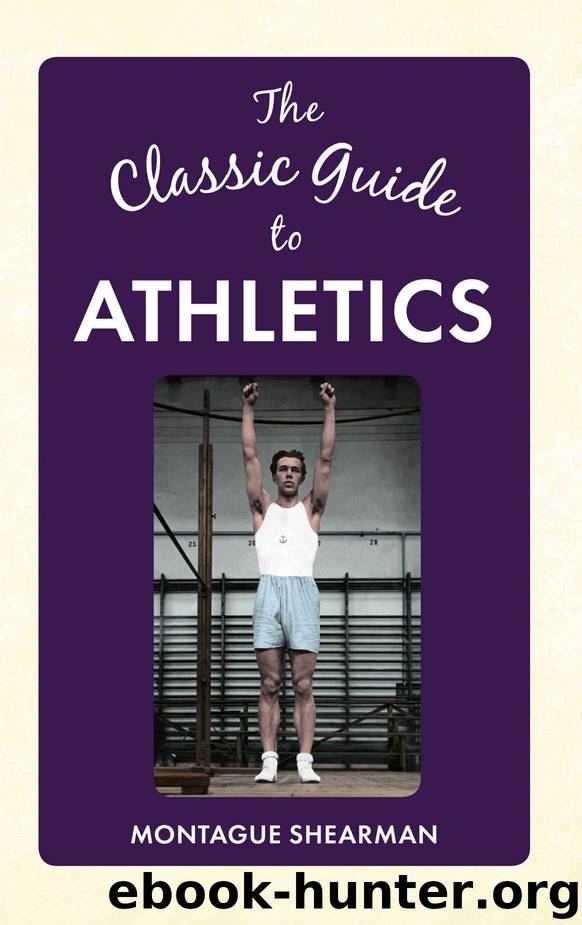The Classic Guide to Athletics by Shearman Montague

Author:Shearman, Montague
Language: eng
Format: epub, azw3
Publisher: Amberley Publishing
Published: 2015-06-14T16:00:00+00:00
4
Jumping, Weight-Putting, etc.
JUMPING
In no branch of athletics have practice and cultivation led to such an extraordinary improvement as in high and broad jumping. At the first Oxford and Cambridge meeting in 1864, the High Jump was won with 5 ft 6 in., the Long Jump with 18 ft, and even at the present day foreigners hear with incredulity that men can jump more than 6 ft in height, and clear more than 23 ft on the flat. The improvement is perhaps more marked in long jumping than in high jumping, but even in the latter, careful training and assiduous practice has shown that the human body is capable of greater feats than were thought possible before jumping became an organised sport. Probably ‘Christopher North’ would have found it as hard to believe that M. J. Brooks jumped 6 ft 2 1/2 in. high in 1876, as did Donald Dinnie, the Scotch ‘professional’, who, on seeing an account of Brooks’ jump, promptly wrote to the papers to show that, upon à priori grounds, such a feat was impossible.
Perhaps nothing is so pretty and interesting as a High Jump, and a light-weight jumper who leaps straight over his obstacle and alights on the balls of his feet is almost certain to be graceful in his movements. Still there are a variety of different styles of high-jumping, and some successful performers get over the bar sideways with a crab-like motion which is more effective than beautiful. The muscles used for the spring are those in front of the thigh which pass down to the knee-cap. The knee is bent when preparing for the spring, the muscles are contracted, and from the sudden and violent straightening of the leg with a jerk, the impetus is given. A high-jumper, therefore, must have these muscles not only strong but naturally springy and elastic, and from this it follows that in a certain sense the high-jumper, like the sprinter, is born, not made; for though muscles can be hardened and strengthened by practice, nothing but nature can make them elastic. As a matter of fact the high-jumper is nearly always short-thighed, with a well-shaped knee, a rather long leg from knee to ankle, and with an ankle, like the knee, cleanly and delicately shaped.
Download
The Classic Guide to Athletics by Shearman Montague.azw3
This site does not store any files on its server. We only index and link to content provided by other sites. Please contact the content providers to delete copyright contents if any and email us, we'll remove relevant links or contents immediately.
Tools of Titans by Timothy Ferriss(7833)
Bodyweight Strength Training by Jay Cardiello(7683)
Born to Run: by Christopher McDougall(6906)
Inner Engineering: A Yogi's Guide to Joy by Sadhguru(6455)
Asking the Right Questions: A Guide to Critical Thinking by M. Neil Browne & Stuart M. Keeley(5371)
The Fat Loss Plan by Joe Wicks(4633)
Bodyweight Strength Training Anatomy by Bret Contreras(4486)
Yoga Anatomy by Kaminoff Leslie(4112)
Science and Development of Muscle Hypertrophy by Brad Schoenfeld(3974)
Dynamic Alignment Through Imagery by Eric Franklin(3931)
ACSM's Complete Guide to Fitness & Health by ACSM(3832)
The Four-Pack Revolution by Chael Sonnen & Ryan Parsons(3802)
Exercise Technique Manual for Resistance Training by National Strength & Conditioning Association(3791)
Bodyweight Strength Training: 12 Weeks to Build Muscle and Burn Fat by Jay Cardiello(3787)
Yoga Anatomy by Leslie Kaminoff & Amy Matthews(3747)
The Ultimate Bodybuilding Cookbook by Kendall Lou Schmidt(3715)
Yoga Therapy by Mark Stephens(3577)
Nutrition for Sport, Exercise, and Health by Spano Marie & Kruskall Laura & Thomas D. Travis(3564)
Nutrition for Sport, Exercise, and Health by Marie Spano & Laura Kruskall & D. Travis Thomas(3558)
